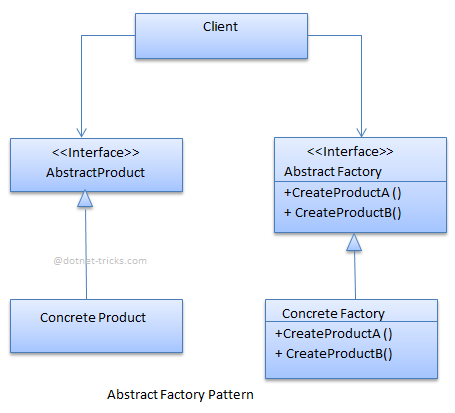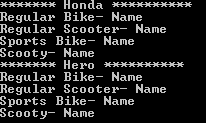Abstract Factory Design method falls under Creational Pattern of Gang of Four (GOF) Design Patterns in .Net. It is used to create a set of related objects, or dependent objects. Internally, Abstract Factory use Factory design pattern for creating objects. It may also use Builder design pattern and prototype design pattern for creating objects. It completely depends upon your implementation for creating objects. In this article, I would like to share what is abstract factory pattern and how is it work?
Abstract Factory patterns act a super-factory which creates other factories. This pattern is also called a Factory of factories. In Abstract Factory pattern an interface is responsible for creating a set of related objects, or dependent objects without specifying their concrete classes.
The UML class diagram for the implementation of the abstract factory design pattern is given below:

The classes, interfaces, and objects in the above UML class diagram are as follows:
This is an interface which is used to create abstract product
This is a class which implements the AbstractFactory interface to create concrete products.
This is an interface which declares a type of product.
This is a class which implements the AbstractProduct interface to create a product.
This is a class which uses AbstractFactory and AbstractProduct interfaces to create a family of related objects.
public interface AbstractFactory
{
AbstractProductA CreateProductA();
AbstractProductB CreateProductB();
}
public class ConcreteFactoryA : AbstractFactory
{
public AbstractProductA CreateProductA()
{
return new ProductA1();
}
public AbstractProductB CreateProductB()
{
return new ProductB1();
}
}
public class ConcreteFactoryB : AbstractFactory
{
public AbstractProductA CreateProductA()
{
return new ProductA2();
}
public AbstractProductB CreateProductB()
{
return new ProductB2();
}
}
public interface AbstractProductA { }
public class ProductA1 : AbstractProductA { }
public class ProductA2 : AbstractProductA { }
public interface AbstractProductB { }
public class ProductB1 : AbstractProductB { }
public class ProductB2 : AbstractProductB { }
public class Client
{
private AbstractProductA _productA;
private AbstractProductB _productB;
public Client(AbstractFactory factory)
{
_productA = factory.CreateProductA();
_productB = factory.CreateProductB();
}
}

The classes, interfaces, and objects in the above class diagram can be identified as follows:
VehicleFactory - AbstractFactory interface
HondaFactory & HeroFactory- Concrete Factories
Bike & Scooter - AbstractProduct interface
Regular Bike, Sports Bike, Regular Scooter & Scooty - Concrete Products
VehicleClient - Client
/// <summary>
/// The 'AbstractFactory' interface.
/// </summary>
interface VehicleFactory
{
Bike GetBike(string Bike);
Scooter GetScooter(string Scooter);
}
/// <summary>
/// The 'ConcreteFactory1' class.
/// </summary>
class HondaFactory : VehicleFactory
{
public Bike GetBike(string Bike)
{
switch (Bike)
{
case "Sports":
return new SportsBike();
case "Regular":
return new RegularBike();
default:
throw new ApplicationException(string.Format("Vehicle '{0}' cannot be created", Bike));
}
}
public Scooter GetScooter(string Scooter)
{
switch (Scooter)
{
case "Sports":
return new Scooty();
case "Regular":
return new RegularScooter();
default:
throw new ApplicationException(string.Format("Vehicle '{0}' cannot be created", Scooter));
}
}
}
/// <summary>
/// The 'ConcreteFactory2' class.
/// </summary>
class HeroFactory : VehicleFactory
{
public Bike GetBike(string Bike)
{
switch (Bike)
{
case "Sports":
return new SportsBike();
case "Regular":
return new RegularBike();
default:
throw new ApplicationException(string.Format("Vehicle '{0}' cannot be created", Bike));
}
}
public Scooter GetScooter(string Scooter)
{
switch (Scooter)
{
case "Sports":
return new Scooty();
case "Regular":
return new RegularScooter();
default:
throw new ApplicationException(string.Format("Vehicle '{0}' cannot be created", Scooter));
}
}
}
/// <summary>
/// The 'AbstractProductA' interface
/// </summary>
interface Bike
{
string Name();
}
/// <summary>
/// The 'AbstractProductB' interface
/// </summary>
interface Scooter
{
string Name();
}
/// <summary>
/// The 'ProductA1' class
/// </summary>
class RegularBike : Bike
{
public string Name()
{
return "Regular Bike- Name";
}
}
/// <summary>
/// The 'ProductA2' class
/// </summary>
class SportsBike : Bike
{
public string Name()
{
return "Sports Bike- Name";
}
}
/// <summary>
/// The 'ProductB1' class
/// </summary>
class RegularScooter : Scooter
{
public string Name()
{
return "Regular Scooter- Name";
}
}
/// <summary>
/// The 'ProductB2' class
/// </summary>
class Scooty : Scooter
{
public string Name()
{
return "Scooty- Name";
}
}
/// <summary>
/// The 'Client' class
/// </summary>
class VehicleClient
{
Bike bike;
Scooter scooter;
public VehicleClient(VehicleFactory factory, string type)
{
bike = factory.GetBike(type);
scooter = factory.GetScooter(type);
}
public string GetBikeName()
{
return bike.Name();
}
public string GetScooterName()
{
return scooter.Name();
}
}
/// <summary>
/// Abstract Factory Pattern Demo
/// </summary>
class Program
{
static void Main(string[] args)
{
VehicleFactory honda = new HondaFactory();
VehicleClient hondaclient = new VehicleClient(honda, "Regular");
Console.WriteLine("******* Honda **********");
Console.WriteLine(hondaclient.GetBikeName());
Console.WriteLine(hondaclient.GetScooterName());
hondaclient = new VehicleClient(honda, "Sports");
Console.WriteLine(hondaclient.GetBikeName());
Console.WriteLine(hondaclient.GetScooterName());
VehicleFactory hero = new HeroFactory();
VehicleClient heroclient = new VehicleClient(hero, "Regular");
Console.WriteLine("******* Hero **********");
Console.WriteLine(heroclient.GetBikeName());
Console.WriteLine(heroclient.GetScooterName());
heroclient = new VehicleClient(hero, "Sports");
Console.WriteLine(heroclient.GetBikeName());
Console.WriteLine(heroclient.GetScooterName());
Console.ReadKey();
}
}

Create a set of related objects or dependent objects which must be used together.
System should be configured to work with multiple families of products.
The creation of objects should be independent of the utilizing system.
Concrete classes should be decoupled from clients.
Internally, Abstract Factory use Factory design pattern for creating objects. But it can also use Builder design pattern and prototype design pattern for creating objects. It completely depends upon your implementation for creating objects.
Abstract Factory can be used as an alternative to Facade to hide platform-specific classes.
When Abstract Factory, Builder, and Prototype define a factory for creating the objects, we should consider the following points :
Abstract Factory use the factory for creating objects of several classes.
Builder uses the factory for creating a complex object by using simple objects and a step by step approach.
Prototype use the factory for building an object by copying an existing object.